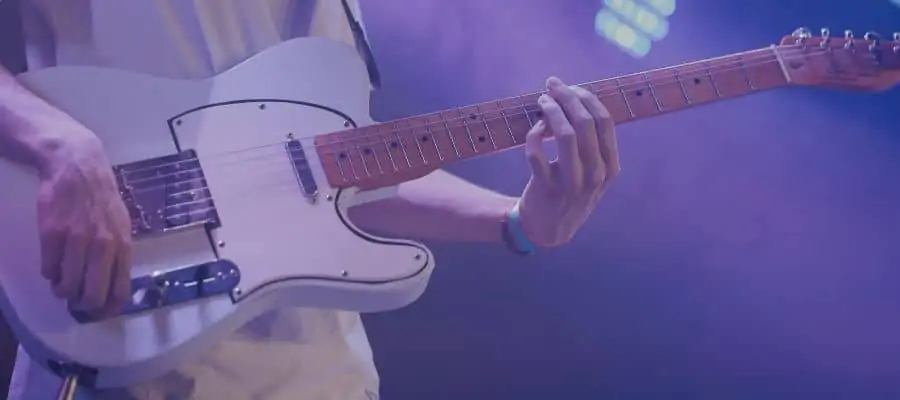Power chords are the muscle cars of the guitar world: fast, powerful, and easy to handle. Even if you’re new to the guitar, you can sound like a rock star by mastering these simple two-note chords. Power chords are built on the root note and the fifth, and sometimes, they include the octave of the root as well. With power chords in your toolkit, you can easily play an array of rock, punk, and metal songs. But can you get by with just power chords?
The answer is yes, especially if your interest lies primarily in genres that thrive on a heavier, more distilled sound. By focusing on power chords, you streamline your learning process, freeing yourself to focus on other aspects of playing, such as timing and technique. This approach is less about traditional music theory and more about getting straight into playing and enjoying the music.
While power chords will let you play many songs, it’s worth mentioning they won’t cover every musical situation. They lack the nuance of full chord shapes, which can limit your expressiveness in specific genres.
However, power chords could be your best friend as a starting point or a way to enjoy playing a wide array of songs with a rockier edge. They are the perfect stepping stone in your guitar journey.
Basics of Power Chords

Playing guitar with only power chords is indeed possible and quite popular in rock, metal, and punk music genres. These chords are stripped-down versions of traditional chords, focusing on the root and the fifth note, making them easier to play and ideal for beginners. Their simplicity offers a solid foundation to play numerous songs across various genres.
Finger Placement and Technique
You can play two-note or three-note power chords. The two-note power chord consists of the root and the 5th, while the three-note power chord has another octave of the root added to the chord.
For a two-note power chord, place your index finger on the root note on the low E or A string. Then, put your ring or pinky finger on the 5th of the root note, one string below. So, for example, for a B power chord, you have to use the 7th fret on the low E string and the 9th fret on the A string. The 5th is always one string below and two frets away from the root note.
For a three-note power chord, you add the octave of the root to the chord. The octave is always on the same fret but one string below the 5th. So, you have to add the 9th fret on the D string for the B power chord. This time, you have to use the pinky finger for the octave, the ring finger for the 5th, and the index for the root note.
- Two-Note Power Chord Shape:
- Index finger: Root note on low E or A string
- Ring or pinky finger: Two frets up on the next string down
- Three-Note Power Chord Shape:
- Index finger: Root note on low E or A string
- Ring finger: Two frets up on the next string down
- Pinky finger: One string down, the same fret as the ring finger
Remember, when strumming power chords, only play the strings your fingers are on. The rest should remain silent.
Tuning and Guitar Setup
Your guitar needs to be properly tuned to ensure your power chords sound as intended. Standard tuning (E A D G B E) works well for power chords, but some players prefer alternate tunings like drop D for easier access to power chords with heavier sounds.
Regarding guitar setup, action, and intonation are critical as they affect playability and chord clarity. Setup your guitar with a comfortable string action and accurate intonation to facilitate clean and powerful chord strikes.
- Guitar Setup for Power Chords:
- Tune: Standard (E A D G B E) or alternate tunings (e.g., Drop D)
- Setup: Comfortable action, accurate intonation
Power chords might be simple in structure, but they are the backbone of many iconic riffs and songs, offering you a straightforward path to rock out on your guitar confidently.
Playing Songs With Power Chords

Power chords are a guitarist’s shortcut to rocking out on many songs across genres, particularly in rock, metal, and punk music. These chords are simple yet potent, typically consisting of the root note and its fifth note. You’ll find power chords easy to learn, offering a fast track to playing full songs even as a beginner.
Song Structure and Composition
You’ll notice that most songs follow a standard structure when jamming with power chords. This often includes verses, choruses, and possibly a bridge or solo section. For instance, the verse might use a progression like E5 – A5 – D5, then switch up to B5 – A5 – E5 for the chorus. Here’s a basic layout:
- Verse: E5 | A5 | D5 | A5
- Chorus: B5 | A5 | E5 | A5
In songs, power chords are played using different strumming patterns or palm muting to match the song’s rhythm. This adherence to structure allows you to quickly learn and anticipate changes in the song, making it easier to play along with your favorite tracks.
Creativity and Adding Variety
Even though power chords might seem basic, you can get creative with them. Adding variety to your power chord songs doesn’t need to be complicated. For instance, you could:
- Slide between chords for a smooth transition.
- Alter the strumming pattern to change the feel of a song.
- Apply a palm-muted technique to create a chugging rhythm.
Try interspersing open chords or single-note riffs between power chord sections to keep things engaging. By incorporating these elements, you add layers and dynamics to your playing, keeping both yourself and the listener intrigued. Remember to experiment and see what resonates with your style.
Conclusion
You can indeed play the guitar using only power chords, but doing so comes with limitations. Power chords provide a straightforward way to add a solid, punchy sound to your playing, typically used in rock, punk, and metal genres.
They are simple to learn and make you sound great quickly, especially when cranking up the distortion for that classic rock vibe. Yet, they lack the tonal variety and complexity of full chords, which include major and minor tones for a richer sound. Embracing power chords is a practical starting point, but to fully explore the guitar’s potential, incorporating a wider range of chords and techniques will significantly enhance your musical expression.
If you found this article useful, you may want to save this pin below to your Guitar board.

Recent Posts
When learning new songs have you noticed that some of the chord sequences sound really good? But when you tried to come up with your own chord sequence, or as we call it chord progression, you found...
Some guitarists insist on buying an expensive amplifier with their electric guitar. They assume that this is a must for every type of guitarist out there. However, in some situations, this isn’t...

